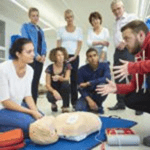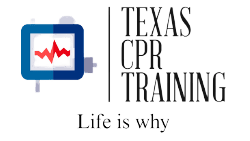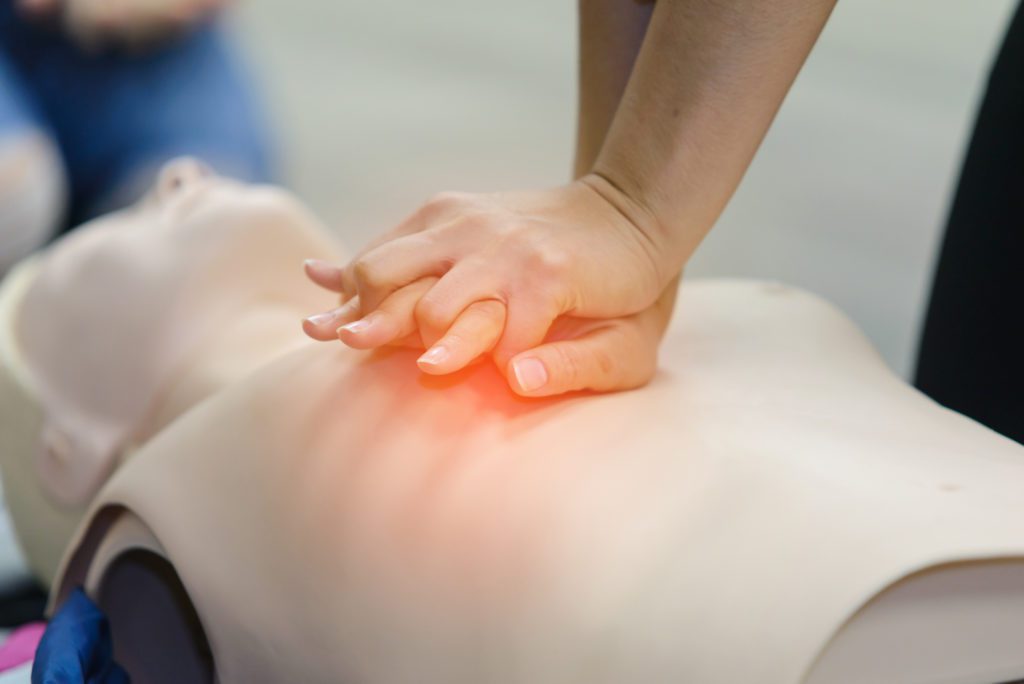The American Heart Association estimates more than 350,000 cardiac arrests occur outside of a hospital each year. This means that more than 350,000 people have their heart stop without a doctor or other medical professional nearby to save them.

The survival of these cardiac arrest victims depends on someone else having CPR and First Aid training, and stopping to provide aid.
Some professions, like police and construction site supervisor, require training for their people. Most people choose to get trained voluntarily. Currently, about half of all Americans report knowing how to perform CPR.
The more people who know CPR, the better the chance that these victims of cardiac arrest can be saved.
Training and certification in both CPR and First Aid will provide you with the skills and confidence you need to help save someone from cardiac arrest.
Not sure what to expect during your CPR training? This cheat sheet will help you feel ready to tackle your CPR and First Aid class.
Deciding to Sign Up
Before you attend a CPR and First Aid class, you’ll need to do a little research to see what kind of class is right for you. You need to register for your chosen class ahead of time. Take a minute to read through the descriptions and pick the right class for you.
Choosing the Right Class
Each class is designed for a specific audience, and based on whom they may need to provide aid to. The general public does not receive the same level of training that paramedics do.
The general public receives a level of training that allows them to sustain life until a medical professional can step in to help the victim.
No matter what level of experience you have, or what job you hold, every class will cover both CPR and First Aid topics. They go hand-in-hand.
Depending on your specific requirements, you may need to take one or more of the following three classes. We also offer combination classes that provide certification in multiple areas.
Adult CPR and First Aid
This is the most basic and commonly chosen class. This class will cover techniques that you would use on adults, teens, and adolescents that are eight years and older.
If you need to know CPR and First Aid for your office workplace, this is likely the class you need to take. If you are a caretaker of an adult, this class is invaluable.
You can choose to add automatic external defibrillator (AED) training to this course. It is never a bad idea to get training in correct AED use. AEDs are now found in most schools and workplaces.
AEDs are becoming more widely available. They can increase the chance of survival when used properly.
Pediatric CPR and First Aid
This course will teach you CPR and First Aid techniques for use on infants and children under eight years old. The technique for resuscitation is different for children than for adults. There is a different compression-to-breath ratio.
If you have small children, or work in a setting where you are the caretaker of small children, this is the course for you. Coaches, daycare providers, school teachers, and babysitters should all have pediatric CPR training.
CPR and First Aid for Professional Rescuers
This training is also known as basic life support, or BLS, training. This is the training required for all emergency medical personnel. It is also usually required for all medical personnel in a hospital or school setting.
If you think you may want to join the medical field in any capacity, you need this training. You do not currently have to be a member of the medical field to choose to take this class.
Online vs In-Person
Once you decide on what type and level of training you need, take a look to see if an in-person or online course is the better fit for your situation.
Taking a class in-person is typically the best choice for first-time trainees. This format of training is more personalized and can involve a greater number of teaching methods.
An in-person instructor can teach the same topic in many ways to make sure the concept is fully understood by every student.
Some people choose to take an online course. An online course is a good option if you have already completed training in the past. It’s also a good choice if you feel comfortable utilizing online material.
Busy professionals find that online training may work better for their schedules. Choose to take an online course if you are unable to attend one of our regularly scheduled courses.
When choosing an online course, please be aware that you will need to schedule a time to perform the hands-on training. The online class allows you to learn the lecture material from your computer. It does not ease the hands-on skills testing requirements.
What to Expect the Day of CPR Training
You found the right class and registered ahead of time for your training. Here’s a quick preview of what to expect during the day of your training.
Before You Leave the House
Double check the address and start time of your training. You don’t want to miss valuable material because you couldn’t find the classroom.
Most CPR classes are in a single, full day format. Some classes split the training into two half-days. Double check to make sure you know what time your class starts and what time it finishes.
Packing lunch or snacks is never a bad option if it’s a full day commitment.
Wear clothes that are comfortable to move around in. You will be getting up to perform mock scenarios during training. Be sure to pick an outfit in which you can easily crouch, bend and kneel.
Plan to arrive a couple minutes before the scheduled start of class. This will give you time to check-in, and collect your training materials.
Lecture Topics That Will Be Covered During Training
Once your class has settled into the classroom, the instructor will typically start with some lecture topics. You can complete this part online if you registered for an online course ahead of time.
Here are some of the topics that should be covered by all of the CPR and First Aid trainings:
First Aid Training
Within the first aid topic, there are several types of emergencies that you will be trained to address. These emergencies range from simple cuts and sprains to serious cardiac events.
Be prepared to cover topics such as:
- Controlling bleeding
- Treating head, neck and back injuries
- Handling minor injuries, such as abrasion, cuts, and burns
- Assessing altered mental states
- Addressing environmental emergencies, such as heat stroke
- Responding to chest pain and shortness of breath
Your instructor will talk to you about the right way to assess an emergency, the importance of offering help, and the need to gain consent before helping someone.
You will learn techniques for making sure the victim is safe and for making sure you are protected. You will learn the importance of calling for professional help right away.
During First Aid training, you will learn the technique of abdominal thrusts to aid someone who is choking. Be prepared to stand up and act out administering aid to a choking victim!
Cardiopulmonary Resuscitation Training
Following, or in conjunction with, First Aid, you will be introduced to the topic of CPR. CPR consists of a combination of chest compressions and administered breaths.
You will learn why CPR is important, how to administer it, and what to expect while you are providing CPR to a victim. You should also expect to learn:
- The signs of a heart attack, stroke, and cardiac arrest
- How to clear an airway
- What to do if there are two rescuers
- How to prioritize care for a victim
- What an AED is and how it works
Your instructor will also talk to you about the Good Samaritan law, your responsibility to try to help, and liability concerns.
You will learn how to take control of a situation to provide the best care possible. This entails learning how to delegate, assign tasks, and remain calm.
Throughout the lecture topics, your instructor should show you how to administer aid in such a way so as to not put yourself at risk at any point.
You should also be prepared to practice CPR techniques and AED use on a dummy.
Hands-On Training
Once you have covered the lecture topics, get ready for the fun part.
If you opted for an online course, you will arrive to class solely for the hands-on training. This training will include the practice of techniques on dummies and role-playing.
Your instructor may choose to incorporate hands-on portions throughout the day to keep the lecture engaging, or save all of the hands-on portions for the same time.
You will likely have to act-out assessing different medical emergencies to ensure you are comfortable with the types of questions you need to ask and your role in the emergency.
Expect to be asked to dress a mock wound or and perform abdominal thrusts on a choking victim. Your course will utilize dummies for the practice of CPR and AED use.
Your instructor will ask you questions and critique your technique. This is done to gauge your understanding and guide your actions. Your instructor is a resource, so ask if you think you may be doing something incorrectly!
Be prepared to practice:
- One-person CPR
- CPR with rescue breaths
- Hands-only CPR
- CPR as part of a 2 rescuer team
- Administering a shock from an AED
Importance of Hands-On Training
Don’t underestimate the importance of hands-on training. This portion of the training gives you muscle memory so that you don’t freeze in a real emergency.
Most people are surprised at how much energy you need to expend to perform CPR correctly. Hands-on training gives you confidence that you are doing the techniques correctly. It also helps you realize the limitations of the care you can provide.
Hands-on training is the experience you can fall back on to help save someone in real-life.
Getting Your Certification
At the end of the lecture and hands-on training, you will be asked to take a test.
There is a written and hands-on portion of the test. Both will cover the topics you have learned during the course of the training.
The hands-on test is an evaluation of your understanding of CPR techniques and AED use. It is usually done as a class. Most times, instructors evaluate your performance during the hands-on training portion.
Then you will be asked to take a written test. Your written test will be graded day-of. You will be informed whether or not you passed the test prior to leaving the classroom.
In the event that you did not pass the test, you will be asked to review the missed material with the instructor. A different version of the test will then be administered.
If you pay attention in class and ask questions about anything that you don’t fully understand, you will be prepared for the certification test.
Be Ready to Use Your Training
People opt out of CPR training because they find the class or coursework intimidating in some way. Knowing what to expect during training can alleviate some of those concerns.
CPR and First Aid training provide you will the skills to help someone during an emergency. Make sure you are comfortable with everything you learned, you know your role in an emergency and you are aware of your limitations.
Don’t forget to keep up-to-date with your training. Regular re-certification classes will make sure you know all the latest tips and techniques.
Keeping up-to-date with your training means that you will always be ready to respond when one of the 350,000 cases of cardiac arrest occurs next year.
Looking for other group training options? Give us a call today about setting up a class for your employees at your workplace. We come to you!
Contact us today with any questions or to get registered for a class.

